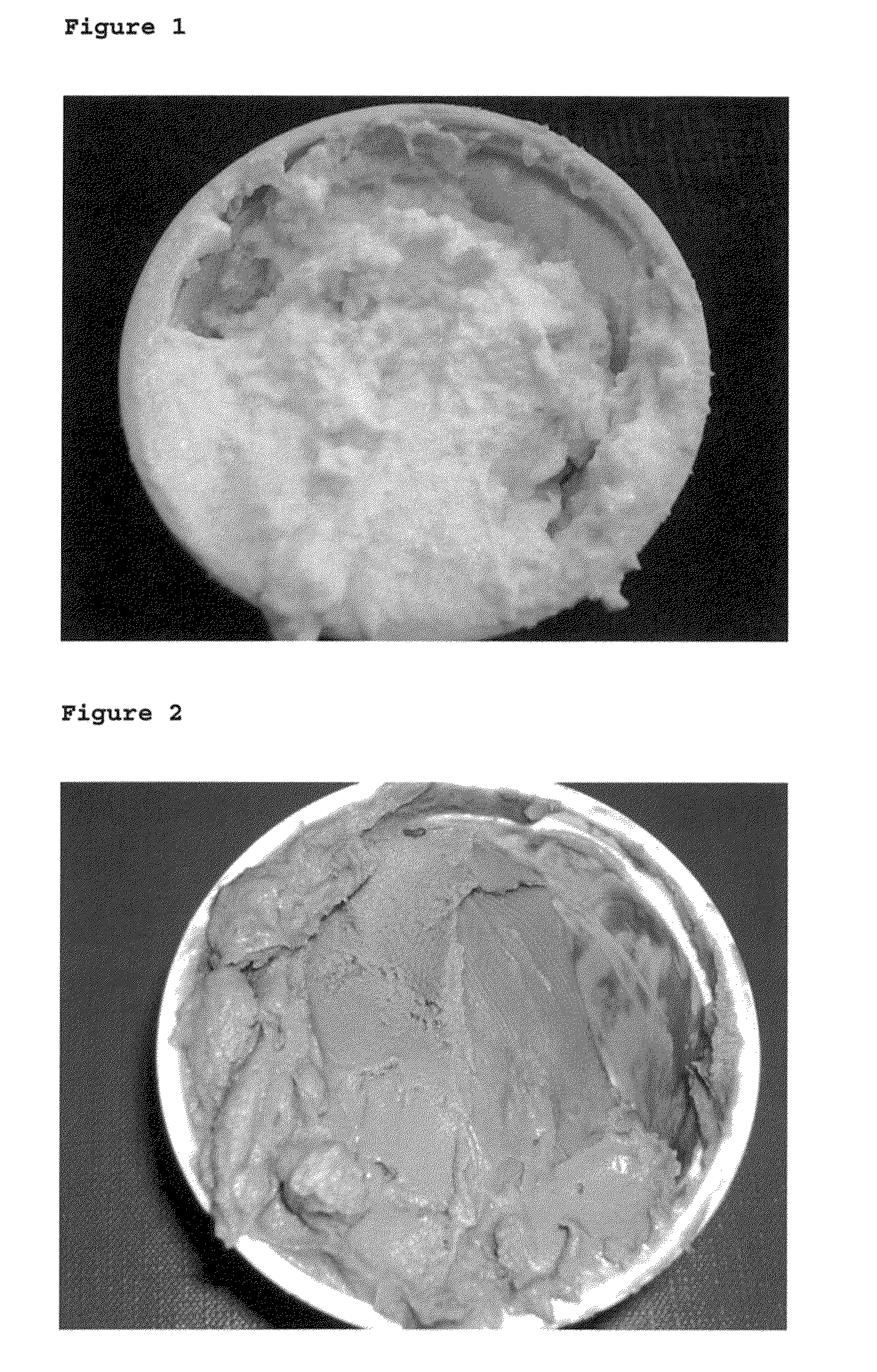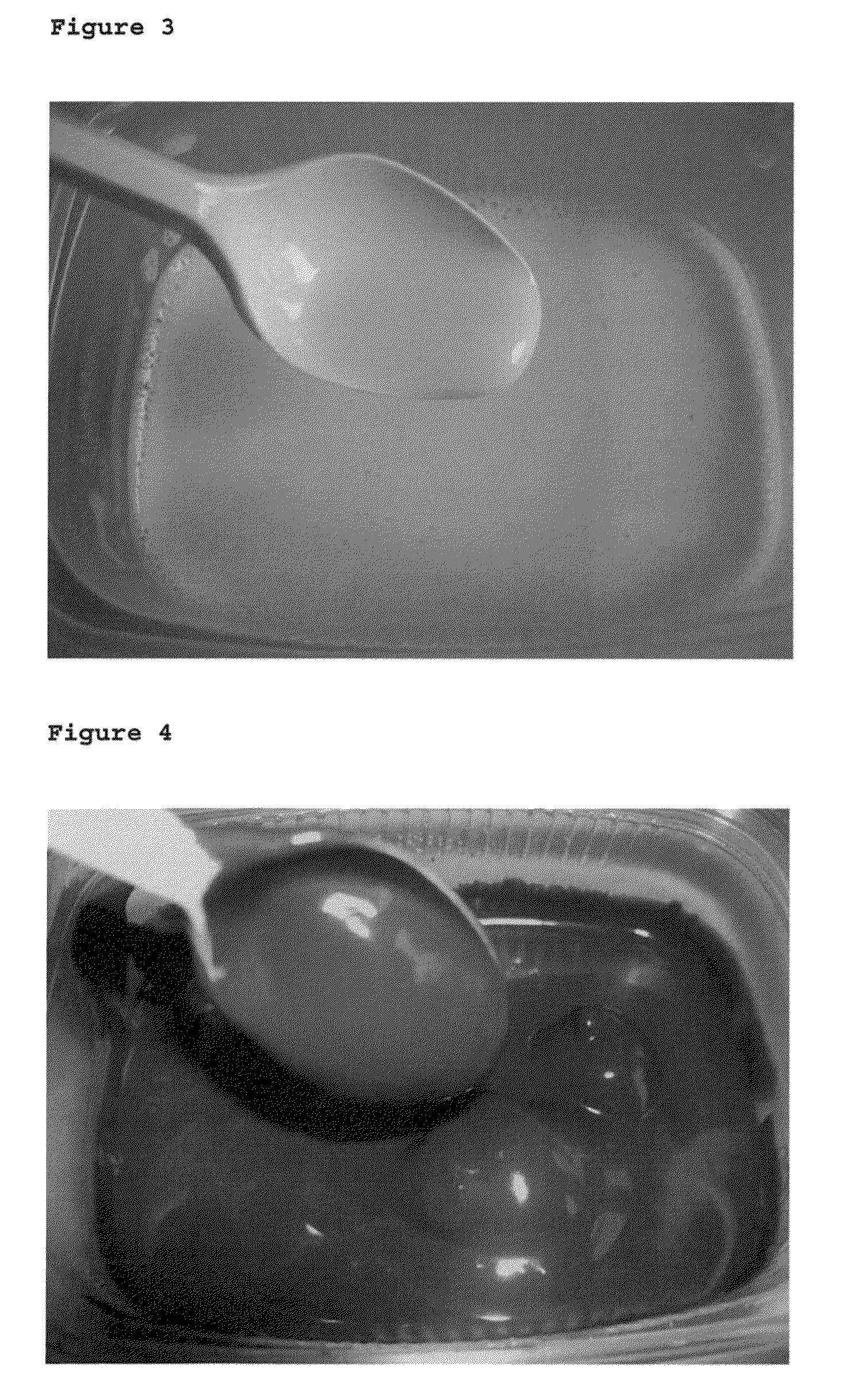Acidified Dairy Food
a dairy food and acidification technology, applied in the field of acidification dairy food, can solve the problems of high cost of cocoa nib processing, high cost of cocoa powder production, bitter aftertaste in foods, etc., and achieve the effect of reducing the fat content and increasing the fibre content of an acidified dairy food
- Summary
- Abstract
- Description
- Claims
- Application Information
AI Technical Summary
Benefits of technology
Problems solved by technology
Method used
Image
Examples
example 1
Cream Cheese Spread Comprising Chocolate, Cocoa Powder and Cocoa Shells
[0064]Composition of cream cheese spread:
Philadelphia Dessert ™ cream cheese spread75.35%(manufactured by Kraft Foods, Ltd.)Milka ™ milk chocolate18.00%(manufactured by Kraft Foods, Ltd.)Non-alkalized cocoa powder1.50%(11% fat; 30% fibre)Ground cocoa shells (6% fat; 60% fibre)1.50%Sucrose3.00%Hazelnut paste0.50%Vanilla flavouring0.10%Hazelnut flavouring0.05%Total fibre:2.1%Total fat:15.3%Total calories (kcal / 100 g):258pH = 5.06
[0065]The spread was found to have a good chocolate taste and produced less sour notes than the spread of the Reference Example.
[0066]The spreadability and mouthfeel of the spread were good. No syneresis, change in flavour or change in spreadability was detected following freezing the spread at −18° C. and thawing to 10° C. Thus, the texture, flavour and stability of the spread were comparable to the spread of the Reference Example.
[0067]The spread had a higher fibre content than the spread...
example 2
Cream Cheese Spread Containing Cocoa Shells and No Cocoa Powder
[0068]Composition of the cream cheese spread:
Philadelphia Light FWPC ™ cream cheese spread52.0%(manufactured by Kraft Foods, Ltd.)Cream (30% fat)23.0%Sucrose17.5%Ground cocoa shells (6% fat; 60% fibre)6.0%Hazelnut paste1.5%Total fibre:3.9%Total fat:14.5%Total calories (kcal / 100 g):237.4
[0069]The spread exhibited a surprisingly good chocolate and creamy taste, even though the spread contained no chocolate. The spread also had a corn-grainwave aftertaste. No bitter or sour notes were detected.
[0070]The spread had a good spreadability, and no syneresis was detected following freezing the spread at −18° C. for 26 days and thawing to 10° C. The spread was also found to be stable following storage at −18° C. for nine months.
[0071]The Stevens value of the spread at 10° C. (St10 value) following freezing at −18° C. for 26 days and thawing at 10° C. for two days was found to be 87 g. The St10 value of the spread following storage...
example 3
[0077]Composition of the cream cheese spread:
Philadelphia Light FWPC ™ cream cheese spread52.0%(manufactured by Kraft Foods, Ltd.)Cream (30% fat)20.0%Sucrose14.5%Ground cocoa shells (6% fat; 60% fibre)12.0%Hazelnut paste1.5%Total fibre:7.5%Total fat:13.9%Total calories (kcal / 100 g):223.8pH = 5.04
[0078]The spread exhibited a good chocolate taste, which was more intense than the chocolate taste of the spread produced in Example 2. The spread was also slightly sweeter than the spread of Example 2, and the spread had a corn-grainwave aftertaste. No bitter or sour notes were detected.
[0079]No syneresis or change in taste, appearance or texture was observed following freezing the spread at −18° C. for 26 days and thawing to 10° C. This was also the case following storage of the spread at 4° C. for 44 days.
[0080]The spread had a significantly higher viscosity than the spread of Example 2. Specifically, the St10 value of the spread following freezing at −18° C. for 26 days and thawing at 10...
PUM
 Login to View More
Login to View More Abstract
Description
Claims
Application Information
 Login to View More
Login to View More - R&D
- Intellectual Property
- Life Sciences
- Materials
- Tech Scout
- Unparalleled Data Quality
- Higher Quality Content
- 60% Fewer Hallucinations
Browse by: Latest US Patents, China's latest patents, Technical Efficacy Thesaurus, Application Domain, Technology Topic, Popular Technical Reports.
© 2025 PatSnap. All rights reserved.Legal|Privacy policy|Modern Slavery Act Transparency Statement|Sitemap|About US| Contact US: help@patsnap.com


